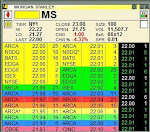
If you like day trading the rush of volatility and reversals in the first and last 15 minutes of each day, then by all means surf that tsunami. For the most part, we prefer to sit on the shore and watch.
Since the death of Lehman last year, the market has shown increased volume and volatility in the first and last half hour of trading. It seems there is no longer a major appetite to hold positions over night. Also contributing to the increased open/close volatility is the volume of HFT (High Frequency Trading) algos being discussed as of late.
Since the death of Lehman last year, the market has shown increased volume and volatility in the first and last half hour of trading. It seems there is no longer a major appetite to hold positions over night. Also contributing to the increased open/close volatility is the volume of HFT (High Frequency Trading) algos being discussed as of late.
Being slow to adapt to market changes can be one of the biggest hurdles we face as a trader.
Looking back the last two months, it became obvious that the first 30 minutes were hurting our end of day performance. Most of the big losers were trades bought or shorted in the first 15 minutes of our live service. The tremendous whipsaw action in this time frame was not only costing us money, but also the opportunity cost of nursing losing positions instead of hunting for better setups. Having to play catchup all day and churn more commissions has been the result of starting too early in this market.
It's been 8 days in a row of starting green and remaining green since making a conscious effort to not trade in the first 25-30 minutes each day. With the exception of one small position here and there, the first 30 minutes have become the "observation" period and avoiding that period has helped the bottom line tremendously. This example is subjective and the point is to look within your own performance to find areas that need improvement or tweaking. Maybe it's the lunch hour that is killing your method?







2 comments:
I can't remember who said this, but I was always told years ago not to trade the first 20-25 minutes of the trading day. "They can see you coming" was the saying when I was day-trading.
Now as a short term position trader, morning gaps are the biggest P/L killer for me. So mornings are still the worst time of day, but mostly because of over-night risk.
~Shepard
=^.^=
This trend of early and late day significant movement is becoming more evident every day. I also heard to aviod the first 20 to 30 minutes of the trading day from one of the analysts on one of the financial news television shows. Glad I heard it, as I also saw too many great starts to trading only to have a major pull back by mid morning.
Even thought I have benefited more than not from the late day rallies, I would be interested in knowing what is driving them.
Dan B.
Post a Comment